Abstract
BACKGROUND:
Bombing is a unique incident which produces unique patterns, multiple and occult injuries. Death often is a result of combined blast, ballistic and thermal effect injuries. Various natures of injury, self referrals and arrival by private transportation may lead to “wrong triage” in the emergency department. In India there has been an increase in incidence of bombing in the last 15 years. There is no documented triage tool from the National Disaster Management Authority of India for Bombings. We have tried to develop an ideal bombing specific triage tool which will guide the right patients to the right place at the right time and save more lives.
METHODS:
There are three methods of studying the triage tool: 1) real disaster; 2) mock drill; 3) table top exercise. In this study, a table top exercise method was selected. There are two groups, each consisting of an emergency physician, a nurse and a paramedic.
RESULTS:
By using the proportion test, we found that correct triaging was significantly different (P=0.005) in proportion between the two groups: group B (80%) with triage tool performed better in triaging the bomb blast victims than group A (50%) without the bombing specific triage tool performed.
CONCLUSION:
Development of bombing specific triage tool can reduce under triaging.
KEY WORDS: Bombing, Blast Injuries, Terrorist Bombings, Triage
INTRODUCTION
Bombing is a unique incident which produces unique patterns, multiple and occult injuries. Death often is the result of combined blast, ballistic and thermal effect injuries. There are walking wounded, hidden and internal injuries. Many non-critical patients who require time intensive workups. Various natures of injury, self referral and arrival by private transportation may lead to “wrong triage”. In India there has been increase in the incidence of bombing.
Blast injuries are physically and psychologically devastating. Although explosions can result from industrial or recreational accidents, terrorist acts that cause injury in military and civilian settings are taking place at an increasing rate.[1]
Historically, civilian care providers and the health-care systems in which they work have been largely spared from managing patients injured by explosions because most blast-related injuries happen in combat settings.
However, nowadays this is not the case. Special-interest, militant, and extremist groups have realized the profound effect explosions can take place in civilian settings. Nightclubs, trains, subways, planes, and other popular sites have been targeted in recent years by these groups and caused substantial civilian casualties.[2]
Bomb blast injuries to civilians in a non-combat setting have become increasingly common over the last decade, mainly as acts of terrorism.[3]
Well-known examples of such acts of terrorism include the Madrid commuter train bombings (March 2004), the London underground bombings (July 2005) and the Oklahoma City bombing (April 1995). Smaller scale but frequent bombings occurred in Israel, Iraq and Pakistan, whereas in Southeast Asia, major cities and tourist sites such as Bangkok (January 2007), Bali (October 2002 and October 2005) and Jakarta (August 2003, September 2004) have also been targeted.[3]
Conservative estimates showed that these events have risen four-fold from 1999 to 2006 worldwide and injuries related to these acts have increased eight-fold (Figure 1).
Figure 1.
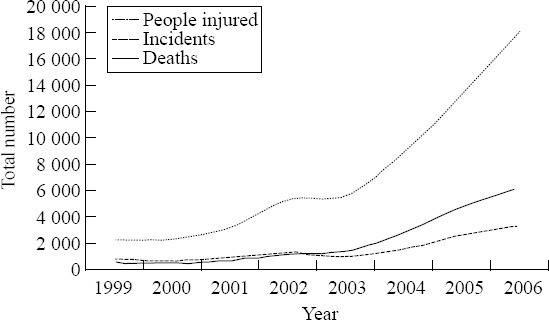
Worldwide trends in terrorist explosive events from 1999 to 2006. Data obtained from RAND®-MIPT Terrorism lncident Database.
There is no documented triage tool from the National Disaster Management Authority for Bombings. Hence, there is a need to develop an ideal triage tool for such incidents.
We developed an ideal bombing specific triage tool which will guide right patients to right place at right time. This will reduce the burden on health care cost, improve the clinical care and will save many lives by proper screening of unique hidden injuries due to bombing.
METHODS
Study design
There were three methods for the study of the triage tool: real disaster, mock drill, and table top exercise. This study was based on a table top exercise. The Scientific Review Board and Ethics Committee Board of the hospital approved the study.
Study setting
The study was done in the emergency department (ED) of an urban, tertiary care facility with an annual footfall of 20 800 patients in New Delhi. The emergency physicians, nurses and paramedics worked in this center.
There were two groups, namely A and B, each containing an emergency physician, a nurse and a paramedic. Baseline training about triaging was provided to the two groups. One group was provided with our BOST triage tool (Figure 2).
Figure 2.
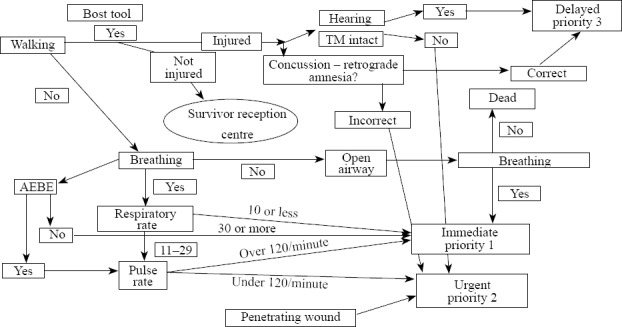
BOST triage tool.
Ten case scenarios were given as simulation exercise and the results of both groups in three categories, i.e. correct, over and under triaging were recorded. The scenario was that of a bomb blast in Lajpat Nagar Central Market in New Delhi. Some of the examples of the cases given to the groups were as follows: (A) A 32-year-old man was found in an alley near the site crying for help. He had a respiratory rate of 36/minute. He was bleeding from the left thigh with shrapnel projecting from the thigh and his radial pulse was absent. (B) A young man sat in front of a shop and asked for help stating that he cannot move his legs; two EMTs rushed to him and asked his name, demographics and description of the event. The patient could not remember what he was doing before the blast occurred. (C) A 58-year-old male vendor was found sitting next to his cart which was 5 meters from the blast site. He was in mild respiratory distress with a respiratory rate of 22/minute and a radial pulse rate of 86/minute. The patient was complaining of pain in the right lower chest and the right upper abdomen. Over triaging (OT), correct triaging (CT) and under triaging (UT) were noted in the two groups.
Statistical analysis
Fisher’s exact test and the Chi-square test were used to prove that both groups were significantly different. P value was calculated using the proportion test.
RESULTS
Each group consisted of an emergency physician, a nurse and a paramedic. Both groups A and B were provided with baseline training about triaging in disaster using triage sieve (Figure 3). Members of group B were then separately trained with the bombing specific triage tool we developed.
Figure 3.
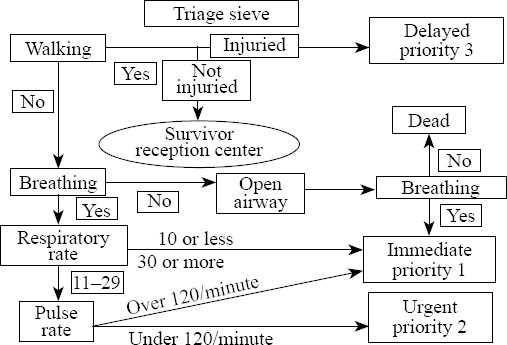
Baseline training about triaging in disaster using triage sieve.
The two groups were given a set of scenarios (n=10) and were asked to do the triaging independently.
The results of using BOST tool in the two groups are shown Figures 4 and 5.
Figure 4.
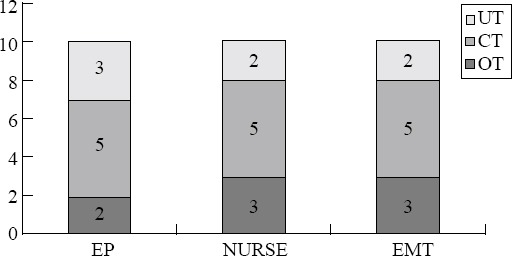
The results of not using BOST tool in group A.
Figure 5.
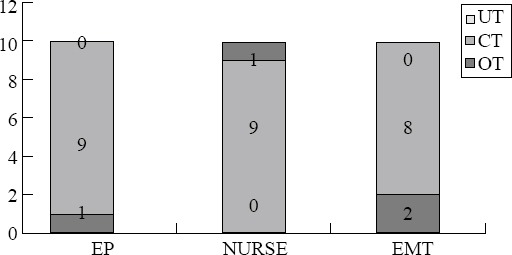
The results of using BOST tool in group B.
The results of both groups are tabulated (Table 1), and Fisher’s exact test and the Chi-square test proved that both groups were significantly different (P value=0.01). Figure 6 depicts the comparison of the two groups.
Table 1.
The results of both groups after different triagings

Figure 6.
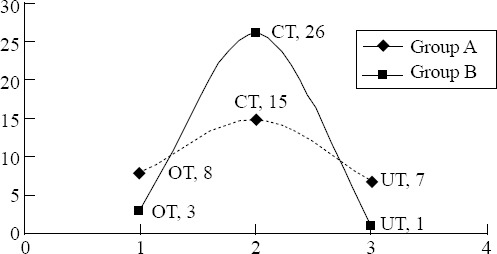
Comparision between group A and group B.
The proportion test showed that CT was significantly different (P=0.005) in both groups in terms of proportion. Group B (80%) with triage tool performed better in triaging bomb blast victims than group A (50%) without bombing specific triage tool.
In UT group B (3%) performed less than group A (23%) (P=0.05). In OT group B (10%) was performed less than group A (26%) (P=0.18).
DISCUSSION
Bomb victims are severely injured and need more medical resources. Mayo and Kluger[4] in Israel found that the number of severely injured (injury severity score ≥16) bomb victims was three times higher than that of conventional trauma victims. It was also found that survivors carry a heavy psychiatric burden in the form of post-traumatic stress disorder (PTSD). This was seen in the Madrid, Israeli and Bali bombings.[2,5–6]
Mass-casualty triage has developed from a wartime necessity to a civilian tool to ensure that constrained medical resources are directed to the greatest use for most of people. Several primary and secondary triage tools have been developed, including Simple Treatment and Rapid Transport (START), JumpSTART, Care Flight Triage, Triage Sieve, SaccoTriage Method, Secondary Assessment of Victim Endpoint (SAVE), and Pediatric Triage Tape.[7]
In 1995, Hodgetts and Mackway-Jones published Triage Sieve (Figure 3) as a component of the Major Incident Medical Management and Support (MIMMS) course for health care providers.[8] The Triage Sieve assigns priority based on the assessments of ability to walk, airway patency, breathing rate, and pulse rate.[9]
Bombings comprise a very different set of injuries in the victims. These are not comparable to injuries sustained in other types of disasters for example in an earthquake or a fire. Keeping the Triage Sieve as a base tool (used for triaging during external disasters), we added few search parameters which are consistent with bomb blast injuries such as hearing, evidence of retrograde amnesia, air entry and evidence of penetrating injuries. Our hypothesis was that adding these search parameters will lead to a significant improvement in triaging (reduction in over and under triaging). We also thought that even with a single session of a table top exercise, the results will be evident.
We selected a mixed group of healthcare providers with three different knowledge levels who will commonly encounter similar exercises. A single training session was organized for one group and the other group was kept as a control group.
The group educated with bombing specific triage tool (a single teaching session) of 30-minute duration scored significantly better than the other group (P=0.005).
The group educated with a bombing specific triage tool had a lower incidence of under triaging than the other group (P=0.05). The intent of development of the bombing specific triage tool was to reduce under triaging. The marginal P value may be the result of a low number of scenarios (n=10) tested among the two groups.
A phase II study using similar methodology but with more scenarios requires to be conducted (n=50).
However, table top exercise is compared to in vitro studies; therefore, a mock drill using the same tool is required to validate the tool.
Footnotes
Funding: None.
Ethical approval: The Scientific Review Board and Ethics Committee of the hospital approved the study.
Conflicts of interest: The authors declare that they have no competing interests.
Contributors: Sanjay J proposed the study and wrote the first draft. All authors read and approved the final manuscript.
REFERENCES
- 1.Wolf SJ, Bebarta VS, Bonnett CJ, Pons PT, Cantrill SV. Blast injuries. Lancet. 2009;374:405–415. doi: 10.1016/S0140-6736(09)60257-9. doi:10.1016/S0140-6736(09)60257-9. Epub 2009 Jul 22. [DOI] [PubMed] [Google Scholar]
- 2.de Ceballos JP, Turégano-Fuentes F, Perez-Diaz D, Sanz-Sanchez M, Martin-Llorente C, Guerrero-Sanz JE. 11 March 2004: The terrorist bomb explosions in Madrid, Spain--an analysis of the logistics, injuries sustained and clinical management of casualties treated at the closest hospital. Crit Care. 2005;9:104–111. doi: 10.1186/cc2995. Epub 2004 Nov 3. [DOI] [PMC free article] [PubMed] [Google Scholar]
- 3.Goh SH. Singapore Med J. 2009;50:101–106. [PubMed] [Google Scholar]
- 4.Mayo A, Kluger Y. Terrorist bombing. World J Emerg Surg. 2006;1:33. doi: 10.1186/1749-7922-1-33. [DOI] [PMC free article] [PubMed] [Google Scholar]
- 5.Aharonson-Daniel L, Klein Y, Peleg K. ITG. Suicide bombers forma new injury profile. Ann Surg. 2006;244:1018–1023. doi: 10.1097/01.sla.0000225355.06362.0f. [DOI] [PMC free article] [PubMed] [Google Scholar]
- 6.Guscott WM, Guscott AJ, Malingambi G, Parker R. The Bali bombings and the evolving mental health response to disaster in Australia: lessons from Darwin. J PsychiatrMent Health Nurs. 2007;14:239–242. doi: 10.1111/j.1365-2850.2007.01068.x. [DOI] [PubMed] [Google Scholar]
- 7.Jenkins JL, McCarthy ML, Sauer LM, Green GB, Stuart S, Thomas TL, et al. Mass-casualty triage: Time for an evidence-based approach. Prehospital Disast Med. 2008;23:3–8. doi: 10.1017/s1049023x00005471. [DOI] [PubMed] [Google Scholar]
- 8.Hodgetts TJ, Mackway-Jones K. Major incident medical management and support: the practical approach. London: BMJ Publishing; 1995. [Google Scholar]
- 9.Garner A, Lee A, Harrison K, Schultz CH. Comparative analysis of multiple-casualty incident triage algorithms. Ann Emerg Med. 2001;38:541–548. doi: 10.1067/mem.2001.119053. [DOI] [PubMed] [Google Scholar]


